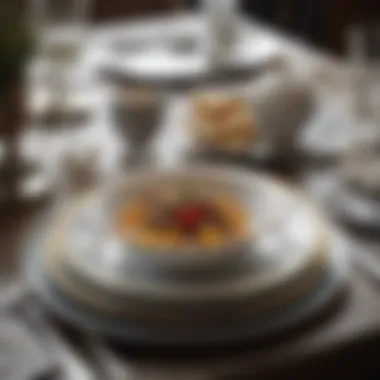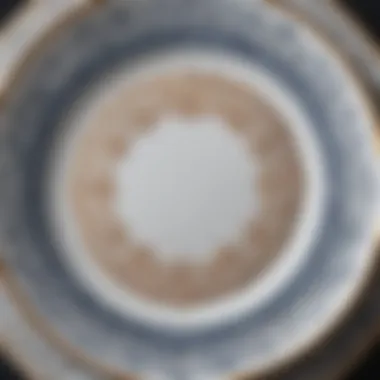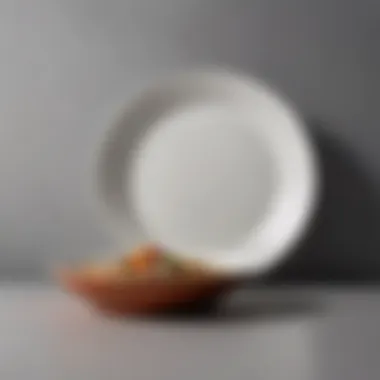Exploring European Dinnerware: Craftsmanship and Trends


Intro
European dinnerware is more than just plates and cutlery; it’s a legacy woven into the fabric of culinary tradition and artistry. From the intricate hand-painted designs of Italy to the refined porcelain of Germany, each piece tells a story, capturing the essence of its region and the craftsmanship behind it. This exploration aims to shed light on the nuances of European dinnerware, delving into its historical significance, the artistry involved, and contemporary trends that influence consumer choices today.
Throughout this article, we will unravel the various materials used, the evolution of styles, and the cultural influences that shape the landscape of dinnerware across Europe. Additionally, we will address the maintenance and care of these exquisite items, helping collectors and enthusiasts to appreciate their investments.
Through a thoughtful examination of craftsmanship, design, and trends, readers will gain insights into how European dinnerware has become more than mere tableware. It serves as a canvas for expression, a reflection of history, and a medium for cultural exchange.
Preface to European Dinnerware
European dinnerware represents not just a means to serve food but a rich tapestry of culture, artistry, and tradition. Each plate, cup, and serving dish can tell a story of the various influences that have shaped culinary experiences across the continent. This section introduces you to the importance of exploring European dinnerware, covering elements like craftsmanship, design variations, and how these pieces resonate with current trends.
In the world of high-end dining and luxury interiors, selecting the right dinnerware is more than a mere choice; it's a statement about one’s taste and appreciation for heritage. European dinnerware often reflects the makers' skill and dedication to craftsmanship. Understanding these pieces allows professionals such as luxury travel curators and fine dining consultants to curate experiences that elevate gatherings and enhance aesthetic appeal.
Historical Context
The roots of European dinnerware can be traced back to ancient civilizations. In the Roman Empire, for example, the use of pottery for dining was prevalent, with techniques evolving over centuries. By the time of the Renaissance, artisans were experimenting with glazes and forms, creating what we recognize today as fine ceramics. Makers in regions like Meissen, Delft, and Limoges began to establish themselves, producing distinctive styles that reflected local cultures and the evolving tastes of the time.
As we moved into the 18th century, porcelain came to reign supreme, especially with the introduction of fine china, which catered to the burgeoning upper class. The significance of the material was not just in its aesthetic but also in its association with luxury and status, linking the tableware directly to the power dynamics of the era. This foundation laid by history not only informs the modern design of dinnerware but also highlights the importance of quality and individuality in contemporary dining narratives.
Cultural Significance
Dinnerware in Europe is interwoven with cultural identity. Different regions boast unique styles that reflect their heritage, traditions, and sometimes even their political histories. For instance, the intricate designs of Italian ceramics often celebrate the country’s rich visual arts heritage, while the precision of German stoneware is a nod to its engineering prowess.
Moreover, dinnerware plays an integral role in various social customs. In many European cultures, the way a table is set can symbolize hospitality and care. From festive gatherings to formal occasions, the dinnerware used impacts the overall mood and aesthetic. It encourages us to highlight the connection to shared meals, evoking memories and fostering relationships.
"Dinnerware is not merely functional; it bridges the past with the present, paying homage to the traditions that shaped today's culinary landscape."
In summary, understanding European dinnerware's historical and cultural contexts enriches our appreciation of these objects as more than just serving tools. They act as cultural vessels that carry forward the legacies of their makers while providing context for modern dining experiences.
Materials Used in European Dinnerware
The materials utilized in the creation of European dinnerware play a vital role in both its functionality and aesthetic appeal. Understanding these materials is crucial for anyone looking to appreciate or acquire quality dinnerware. Each material brings with it unique characteristics that define its usage, durability, and design potential, contributing to the overall dining experience.
Porcelain
Origins of Porcelain
Porcelain has its roots in China, dating back to the Tang dynasty (618–907 AD) when it was first crafted. The term "porcelain" itself derives from the Italian word porcellana, which means cowrie shell, reflecting its smooth and lustrous surface. Its introduction to Europe in the 16th century marked a significant milestone in dining culture, intertwining luxury and artistry. Porcelain's key characteristic is its ability to achieve an intricate balance of fragility and strength. This makes it a popular choice for fine dining, as it can be crafted into delicate, thin-walled pieces that are nonetheless durable enough for everyday use.
One unique feature of porcelain is its translucent quality; light passes through, giving an ethereal glow that enhances food presentation. However, it can be susceptible to chipping, and thus it requires careful handling, which might be a disadvantage in casual settings.
Manufacturing Process
The manufacturing process of porcelain is both an art and a science. Initially, kaolin clay is blended with other materials like feldspar and quartz to create a workable paste. This mixture is then shaped into desired forms, traditionally through methods like throwing on a potter's wheel or slip casting. The pieces are then kiln-fired at high temperatures, sometimes exceeding 1300 degrees Celsius, which triggers a chemical transformation that strengthens the clay.
The most notable aspect of this process is the glazing stage, where a glass-like coating is applied, enhancing both durability and aesthetics. This makes porcelain a beneficial choice for collectors and places it at the higher end of the dinnerware spectrum. Its unique advantage lies in the breadth of finishes available, from matte to high gloss, allowing for diverse design options. However, the kiln firing makes it more costly to produce.
Types of Porcelain
Porcelain can be categorized into several types, each contributing distinctively to the European dinnerware market. The three primary types are hard-paste, soft-paste, and bone china. Hard-paste porcelain, the oldest variety, offers superior strength and durability, often used for tableware destined for high-end venues. Soft-paste porcelain tends to be less durable but is easier to craft intricate designs. On the other hand, bone china, composed of bone ash, is known for its exceptional whiteness and translucency, striking a balance between elegance and toughness.
Each type is beneficial in its own right; for instance, bone china is highly favored in fine dining due to its elegant appearance, yet it can be more expensive, affecting accessibility.
Stoneware
Characteristics
Stoneware boasts exceptional strength and versatility, achieved through its unique composition and firing process. Made from a mix of clay and other materials, it has a dense, opaque structure that makes it non-porous and resistant to chipping. The surface is often finished in earthy, rustic glazes, making it particularly appealing for informal dining settings.
This material is incredibly durable and retains heat well, an advantageous trait for serving hot dishes. However, its weight can be a drawback; heavier pieces might not be ideal for all users, especially during prolonged meal times.
Common Uses
Commonly used in both casual and formal dining scenarios, stoneware finds its place in everyday households and upscale restaurants alike. It is favored for baking dishes, casseroles, and even dinner plates due to its heat retention properties. Additionally, many artisanal producers craft one-of-a-kind pieces, enhancing its charm for collectors.


Its rustic aesthetic aligns well with contemporary trends leaning towards authenticity and natural textures in table settings. While its wide applicability is beneficial, it may struggle to fit the sleek, polished trends sought by some luxury environments.
Key Regions of Production
Europe hosts a few key regions renowned for stoneware production. The Netherlands is famous for its traditional Dutch stoneware, characterized by intricate blue and white designs. In Germany, regions like Westerwald and Saar have a rich history of crafting stoneware items. The unique characteristics of these regions often define the style, glazing techniques, and patterns, making their products easily recognizable.
What adds to the allure is how local clays influence color and texture, resulting in diverse products that appeal to collectors and home chefs alike. However, the reliance on specific regional materials can sometimes limit production capacity in high-demand seasons.
Earthenware
Features and Benefits
Earthenware is one of the oldest forms of ceramic and is known for its rustic charm. Composed of clay fired at lower temperatures than stoneware, its porous nature gives it a unique aesthetic. The primary benefit of earthenware is its versatility; it can create a wide range of styles and colors, from terracotta rustic pieces to glossy, intricate patterns.
However, one significant disadvantage lies in its susceptibility to staining and chipping, leading to careful consideration for everyday use. Depending on the glaze applied, it can be either practical or purely decorative, addressing a broader consumer base.
Popular Styles
Various popular styles emerge from earthenware production, including Mediterranean, Mexican Talavera, and English Cottage designs. Each style encapsulates specific cultural elements, offering a slice of tradition at the dining table.
For those seeking something bold and striking, the vibrant colors of Talavera can elevate any meal, while the rusticity of Mediterranean pieces adds warmth to gatherings. While earthenware can be an excellent choice for thematic dining, its robustness may be questioned in high-end settings where durability is paramount.
Historical Relevance
Earthenware embodies a rich historical tapestry, reflective of various cultures and their evolution in pottery techniques. Dating back to ancient civilizations, it serves as a testament to humanity's relationship with fire and clay. This historical context adds depth and significance, making earthenware not just functional but also an art form rooted in tradition.
The penetration of various cultural influences is seen in the designs and forms of earthenware; for example, the elaborate detailing in Islamic pottery or the simplistic beauty found in indigenous pottery. Its accessibility and variety serve to keep earthenware relevant in today’s market, appealing to a broad audience through its storytelling capacity.
Influential Regions in Dinnerware Production
Understanding the regional influences in dinnerware production sheds light on the diverse styles and craftsmanship found across Europe. Each area boasts unique techniques and artistic expressions that reflect its cultural heritage. Not only do these regions produce beautiful pieces, but they also embody centuries of tradition and innovation that resonate with collectors and enthusiasts alike.
Italy: A Legacy of Design
Italian dinnerware is synonymous with elegance and flair, deeply rooted in the nation's artistic heritage. The craftsmanship here has stood the test of time, making it a favored choice for those who appreciate beauty in function.
Classic Manufacturers
Classic manufacturers like Richard Ginori and Wedgwood exemplify what Italian dinnerware is all about. Renowned for their intricate hand-painted designs and luxurious materials, these brands offer pieces that transcend mere utility. The exquisite detailing is a hallmark of their craftsmanship, providing a singular experience when paired with fine dining environments.
One captivating aspect of these manufacturers is the range of artistic styles they embrace, from the Renaissance revival to modern interpretations. Their ability to adapt while maintaining quality speaks volumes about their dedication to excellence. However, pricing can be steep, which may not sit well with every buyer.
Signature Styles
Signature styles in Italian dinnerware often revolve around vivid colors and elaborate motifs, capturing elements of Italy’s rich landscape and history. These patterns can be found on various pieces, from elegant plates to stunning serving ware.
One standout feature is the use of traditional glazing techniques that enhance colors, making them pop like fine art. These styles are not just decorative; they also serve as conversation starters at any gathering. The downside, however, might be their fragility, which can lead to concerns over long-term usage.
Germany: Precision and Quality
Germany's dinnerware production is characterized by its focus on precision and high-quality materials. Brands such as Meissen and Villeroy & Boch have made their mark on the international stage, emphasizing craftsmanship that merges function with form.
Notable Brands
Notable brands stand out for their revolutionary approaches, using advanced techniques that blend tradition with modern technology. For instance, Meissen is famous for its hand-painted porcelain, often considered the epitome of quality.
The precision in every artwork is a clear reflection of Germany's engineering prowess. This high standards of production not only attract collectors but also command a hefty market value. On the flip side, the meticulous craftsmanship does make these pieces a tad more expensive compared to their counterparts.
Cultural Impact
The cultural impact of German dinnerware extends beyond aesthetics. It plays an integral role in culinary traditions, seen during festive occasions and family gatherings.
The influence can be seen in how dinnerware complements the meal itself, elevating the dining experience. These pieces are more than mere dishes; they embody a sense of quality and sophistication. However, for those seeking contemporary flair, traditional designs may not always resonate.
England: Tradition Meets Modernity


As home to brands like Royal Doulton and Spode, England’s dinnerware production showcases a blend of historical craftsmanship with modern innovations. This mix creates unique pieces that appeal to a wide range of tastes, from traditional to contemporary.
Historical Evolution
The historical evolution of English dinnerware tells a story of innovation. The shift from earthenware to fine bone china exemplifies how the industry has adapted over centuries.
An important aspect of this evolution is the incorporation of intricate designs and patterns that tell the story of England’s society through time. This makes English dinnerware not just functional but significant in a cultural context as well, appealing to those wanting a connection to history.
Contemporary Innovations
In today’s market, contemporary innovations are taking center stage. Brands are now experimenting with shapes, colors, and materials, often blending traditional styles with modern aesthetics.
For example, new sustainable materials are being explored, making dinnerware more eco-friendly while still being chic. This evolution offers versatility, catering to the preferences of the discerning buyer. However, the risk lies in moving too far from classical designs, which could alienate traditionalists.
With each region showcasing its strengths, European dinnerware stands as a testament to the rich tapestry of craftsmanship and artistry, catering to both historical appreciation and modern-day needs.
Design Trends in European Dinnerware
The world of European dinnerware is a canvas of cultural expression and aesthetic evolution. Trends in design represent not only changing tastes but also reflect broader movements in society, art, and technology. For those involved in luxury travel, fine dining, and interior design, understanding these trends is essential. They help in curating experiences that resonate with guests, ensuring that each meal is a feast for both the palate and the eyes.
Floral Patterns and Motifs
Floral patterns have remained a perennial favorite in European dinnerware design. They evoke feelings of warmth and charm, making any dining experience feel more intimate and inviting. These delicate designs often tell stories of cultural significance and artistic heritage. For example, the intricate floral patterns of Royal Worcester porcelain often pay homage to nature, reflecting the seasonal blooms of the English countryside.
It's crucial to recognize how these motifs not just beautify the table, but also symbolize connection to nature and nostalgia for simpler times. Choosing pieces adorned with such patterns can elevate the experience for guests, making meals feel like special occasions rather than everyday affairs.
Minimalist Aesthetic
In contrast to floral extravagance, the minimalist aesthetic embodies the principle of 'less is more'. It focuses on clean lines, understated colors, and simplicity. This trend has gained traction, particularly among modern designers who align with the Scandinavian style. Brands like Villeroy & Boch have embraced minimalism, creating dinnerware that complements contemporary architecture and decor.
A minimalist set allows the food to take center stage. It removes distractions, enabling the vibrant colors of the meal to shine through. Additionally, the practicality of these designs promotes versatility; pieces can seamlessly transition from formal gatherings to casual brunches. For those in high-end interior design, curating a dining experience with minimalist tableware can signify elegance and sophistication.
Bold Colors and Geometric Shapes
Another exciting trend in European dinnerware is the use of bold colors and geometric shapes. Designers are shifting away from traditional whites and pastels, opting for eye-catching hues that stimulate the senses. This contemporary movement can be traced back to mid-20th century art movements, where vibrant colors and abstract forms played significant roles.
A dinnerware collection infused with bold colors can instantly transform a table setting into a dynamic visual experience. Geometric shapes, from hexagons to asymmetrical designs, add a layer of intrigue and modernity. Consider the innovative designs by brands such as Alessi, whose pieces combine functionality with artistic exploration. These options can be particularly appealing for luxury event planners who seek to leave a lasting impression.
In summary: The interplay between these design trends offers valuable insights into personal style and cultural influences. Whether one leans towards traditional floral patterns, embraces the minimalist vibe, or dares to explore bold colors and geometric shapes, European dinnerware continues to evolve, ensuring that the dining experience remains rich and engaging.
The Role of Dinnerware in Social Gatherings
Dinnerware is not merely about serving food; it acts as a silent communicator in social settings, shaping the dining experience and influencing the interactions between guests. The choice of dinnerware can subtly convey hospitality, culture, and a host’s thoughtful attention to detail. In effect, it becomes a part of the gathering itself, enhancing the overall atmosphere. When one thinks about a meal, the visual elements, the tears and layers of the table settings can create a compelling prelude.
Gatherings, whether they're family dinners, holiday feasts, or elegant events, often come to life even before the first course is served. The dinnerware plays an essential role, elevating simple ingredients into culinary masterpieces through aesthetic appeal.
Setting the Table: A Visual Delight
Setting a table with care can transform an everyday meal into an occasion. Picture this: a beautifully set table with gleaming porcelain plates, perfectly aligned forks and knives, and a centerpiece that captures the essence of the season. Each piece of dinnerware, from a delicate saucer to an intricately patterned bowl, contributes to this visual delight.
The arrangement of the dinnerware can reflect the theme of your gathering. For instance, using blue and white porcelain evokes Mediterranean vibes, whereas rustic earthenware might instill a cozy, homely feel. Form and function marry gracefully as textures, colors, and patterns dance together to tell a story.
- Consider the following elements when setting your table:
- Color Palette: Choose shades that evoke the mood you want to create.
- Layering: Textured tablecloths under the dinnerware can enhance the visual depth.
- Height Variation: Keep tall centerpieces for visual interest, while ensuring they don't obstruct guests’ views.
- Lighting: Notice how different light sets the mood for the dinnerware.
With these aspects in mind, setting the table can be a true art form, combining craftsmanship, tradition, and personal flair into a cohesive experience.
"The right dinnerware not only serves food—it serves conversation, emotion, and memory."
Cultural Rituals and Dining Etiquette
The dinner table is a stage of its own, where cultural customs and etiquette unfold. Each country in Europe has its unique dining rituals, and dinnerware is often at the forefront of these practices.
From the finely decorated Royal Copenhagen porcelain used in Danish gatherings to the vibrant hand-painted ceramics found in Spanish homes, each piece has a story that often reflects cultural values and history. Dining etiquette varies widely: some cultures place significant emphasis on the order of plates and cutlery, while others may focus more on communal sharing of dishes.


- Key considerations in dining rituals include:
- Order of Service: Traditional meals may follow a specific pattern with distinct plates for each course.
- Local Customs: Paying attention to whether to use a knife and fork, or when it’s appropriate to eat with one’s hands.
- Symbolism: In some cultures, specific dinnerware might be used for certain occasions, marking celebrations or commemorative events.
By understanding these elements, we not only respect the cultures we engage with but also enrich our own dining experiences. Thus, the role of dinnerware in social gatherings goes beyond mere functionality. It cultivates collaboration across cultures, reminding us that at its heart, dining is about connection.
Maintaining and Caring for European Dinnerware
European dinnerware is as much about aesthetics as it is about function. Its craftsmanship can be a family heirloom or a prized possession, so understanding how to maintain and care for it is crucial. The life expectancy of these beautiful pieces can be extended through careful handling and proper cleaning techniques.
Cleaning Techniques
When it comes to cleaning European dinnerware, gentleness is key. While some materials can withstand a little rough treatment, others require a soft touch. Here’s a practical guide to keep your dinnerware in pristine condition:
- Hand Washing: Whenever possible, opt for hand washing instead of the dishwasher. Use warm water with a mild detergent. Avoid harsh chemicals that can dull the finish.
- Soft Cloths: When drying your items, use a soft cloth or microfiber to prevent scratches. Avoid abrasive pads or towels; they can damage delicate patterns.
- Avoid Extreme Temperatures: Sudden temperature changes can be detrimental to dinnerware, especially porcelain and some stoneware. Always let them cool down before washing in cold water.
- Stain Removal: For stains, consider using a paste of baking soda and water. Apply it gently with a soft cloth, and rinse thoroughly afterwards to avoid residue.
"The right cleaning technique not only preserves aesthetics but can enhance the functional longevity of fine dinnerware."
Long-Term Preservation Tips
Caring for your dinnerware doesn’t end with cleaning. Proper storage and maintenance can elevate your collection into lasting treasures:
- Storage Solutions: Store dinnerware in a dry, cool place. If stacking dishes, use cloths or paper between them. This prevents scratching or chipping.
- Regular Inspection: From time to time, take a closer look at your dinnerware. Check for signs of wear and tear or tiny chips that could become larger problems. Address any issues at once.
- Limit Exposure to Direct Sunlight: Excessive sunlight can fade colors and patterns over time. Display these beauties with a mind toward their longevity.
- Use Them Regularly: It may seem counterintuitive, but using your dinnerware can actually be beneficial. The act of regular cleaning and handling can help you spot potential issues before they become serious.
Maintaining and caring for European dinnerware is a practice that reflects an appreciation for artistry and craftsmanship. By following proper techniques for cleaning and preservation, collectors can ensure that these exquisite items remain both functional and beautiful for generations to come.
The Investment Value of European Dinnerware
The Investment Value of European dinnerware extends beyond just a set of plates and cups; it encapsulates artistry, history and a certain prestige that can enhance any dining experience. For collectors and connoisseurs alike, these pieces can serve as both functional items and pieces of art that appreciate in value over time. Understanding the factors that contribute to their investment potential is essential for anyone looking to make informed decisions in this captivating market.
Market Trends and Valuation
In recent years, the market for European dinnerware has seen a notable surge in interest. With luxury lifestyles on the rise, savvy buyers are looking for more than just aesthetic appeal; they want pieces that carry weight in terms of investment. The global market for high-end dinnerware reflects changing consumer preferences driven by factors such as scarcity, brand heritage, and craftsmanship.
- Scarcity: Certain lines of dinnerware from well-known manufacturers can become incredibly rare. Consider limited edition sets or discontinued patterns; these often fetch high prices due to their limited availability.
- Brand Heritage: Brands like Wedgwood or Villeroy & Boch carry with them a legacy that's hard to match. Collectors often seek out pieces from renowned makers, knowing that these hold their value well and are often passed down through generations.
- Craftsmanship & Design: Unique designs and intricate craftsmanship contribute significantly to a piece's value. Hand-painted details, artisan techniques, and the quality of materials used can dictate pricing levels, making them attractive both to collectors and investors.
Conversely, trends in market valuation for European dinnerware are subject to shifts based on contemporary tastes. Pieces that once seemed obsolete due to modern minimalist trends can regain popularity, leading to surprising valuation spikes. Knowledge of these trends can give collectors an upper hand in navigating their purchases and sales effectively.
Collectible Sets and Rarity
When one thinks of investing in dinnerware, the notion of collectible sets often springs to mind. These are not merely dishes to eat from; they are treasures that tell stories. Collectible sets typically include limited editions and unique themes, which can significantly boost their value over time. Some aspects to consider when looking into collectible dinnerware are:
- Provenance: Knowing the history of a piece can add to its allure. Items associated with significant events or famous figures often attract a premium.
- Condition: Well-preserved pieces are more valuable than those that show signs of wear and tear. The original packaging can also increase a set's desirability.
- Diversity in Styles: Many collectors enjoy diversity in their collections, which means a variety of styles can be advantageous. Mixing more traditional pieces with modern ones can create a narrative that highlights the evolution of European dinnerware.
To reinforce the notion of rarity, consider this:
"In the world of European dinnerware, rarity creates desirability, and desirability enhances value."
Investing in collectible sets of European dinnerware can yield lucrative returns, but knowledge is key. Understanding what makes a piece collectible and the elements of rarity can ensure a more prosperous investment.
The End
In wrapping up our journey through the intricate world of European dinnerware, we uncover not just the tangible beauty of these items but also their enduring legacy. European dinnerware has much to teach us about history, culture, and artistry, bridging generations while enhancing our dining experiences. This conclusion serves to reflect on specific elements that underline the significance of these pieces, the benefits they bring, and the broader considerations they entail for both the collector and the casual observer.
Reflecting on the Legacy of European Dinnerware
European dinnerware serves as a testament to centuries of craftsmanship. It represents a confluence of various regional styles, traditions, and technological advancements that have evolved over time. Each piece tells a story, rich with the nuances of the artisans who shaped it, the historical events that influenced its design, and the cultures that embraced it.
From the elegant Rennaissance motifs of Italy to the precise engineering of German porcelain, the legacy found in these wares is profound. They reflect not just personal tastes but also social statuses, having adorned tables of the elite while simultaneously being appreciated in households across various social strata. The delicate craftsmanship and unique artistry elevate dining into an experience that transcends mere eating, adding richness to gatherings and celebrations.
"Dinnerware is not just tableware; it's an expression of culture, history, and artistry."
While many might view dinnerware simply as functional items, their significance goes much deeper. They are heirlooms, passed down through families, capturing memories of shared meals and milestones. Thus, understanding and appreciating this legacy is crucial, especially for luxury curators and designers who seek to create not just a setting, but a lasting impact on the dining experience.
Future Perspectives in Dinnerware Design
As we look towards the horizon, the field of dinnerware design is ripe for innovation while remaining rooted in tradition. Modern designers are increasingly blending age-old techniques with contemporary aesthetics. This intersection is manifesting in various ways, including:
- Sustainability: With eco-friendliness at the forefront, there's a noticeable shift towards utilizing sustainable materials and practices. This trend poses both opportunities and challenges, as designers must balance durability, functionality, and environmental consciousness.
- Customizability: Consumers are increasingly seeking personalized dining experiences. The rise of bespoke dinnerware, allowing for unique pieces tailored to individual preferences, signals a shift from mass production to more handcrafted, personal artistry.
- Technological Integration: Advanced technologies, such as 3D printing, are giving designers new avenues to explore innovative shapes and patterns that were previously unimaginable. This marriage of technology and artistry holds potential for a new wave of uniquely designed dinnerware.
In diagnosing future trends, it becomes evident that European dinnerware design will continue to evolve, marrying tradition with innovation. For connoisseurs and collectors alike, keeping an eye on these developments ensures they remain engaged with a vibrant market that reflects not only aesthetic preferences but also broader societal shifts.
Ultimately, the narrative of European dinnerware continues to unfold, steeped in history yet ever-sensitive to the currents of contemporary life. By appreciating both the legacy and future potential, one can fully grasp the importance of this exquisite craft.







